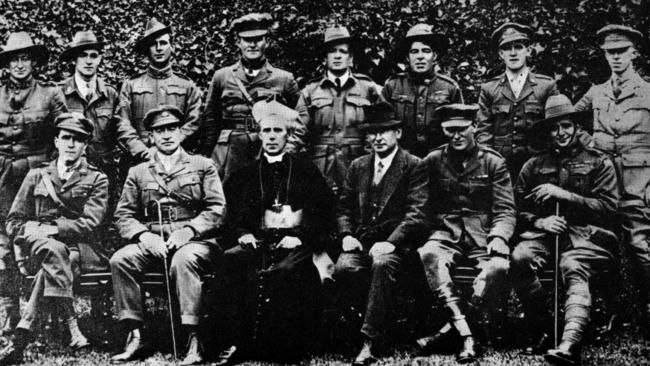Archbishop Daniel Mannix: Brenda Niall looks beyond the legend
Brenda Niall’s magisterial biography of archbishop Daniel Mannix comes into its own when delving into his Australian days.

A brush with greatness becomes a high point in any life, a non-deletable item in a CV. The more unique or bizarre it is, the more indelibly it remains. On November 5, 1963, the afternoon Gatum Gatum won the Melbourne Cup, I was an 18-year-old Jesuit novice working at Caritas Christ Hospice for the Dying in Kew, Melbourne. Ten days previously I’d been given a half-hour next door at Raheen with the Catholic archbishop of Melbourne, Daniel Mannix. He’d told, with masterly dramatic flair, a never-to-be-forgotten story about himself and the duke of Norfolk in Rome about 1890.
On the afternoon of the cup my novice companion and I were summoned back urgently. The 99-year-old Mannix was still in his chair, but his head was lolling and his biretta had toppled on to the ground. We novices had one function there: my companion, formerly a New Zealand dairy farmer, took the archbishop under the arms and I lifted him by the legs, and with our shoes still on we clambered and hoisted him on to his high double bed.
It was all scandalously wrong; Mannix laid on his deathbed by two foreigners, I being a Sydney boy for whom the name Mannix still lacked resonance.
Now I learn from Brenda Niall’s calmly magisterial biography that Mannix was never seen bareheaded and never liked to be touched. (He always cut his own hair!) More significantly, Niall gives a sense of Mannix’s greatness and of why we can still be awed by him.
Yet not initially. The first two chapters are extended exercises in admitting we haven’t a clue. Niall opens her book on a suitably Irish note of loss; nearly all Mannix’s private papers were deliberately destroyed. Born in 1850 near Charleville in County Cork, Mannix spent his first 50 years, half his lifetime, in Ireland, yet Niall devotes only 41 pages to this half, whereas his tenure as archbishop of Melbourne gets 311 pages. The fact is there is nothing to be told of his pre-emigration life. Beyond genealogical, scholastic and professional appointment facts, we have no idea of his family life, his friendships, his boyhood interests, his seminary days or even of his reasons for becoming a priest.
Two factors allow Niall to come into her own for Mannix’s Australian days.
First, he transformed himself (but we don’t really know why) from a remote overseer of a rural seminary in County Kildare into a headline-grabbing public figure thanks to the Great War and Australia’s conscription debates. Second, she is able to supplement her research and multiple interviews with those done for the previous eight biographies of Mannix (surely an unrivalled Australian tally).
Niall never talks about greatness but the character comes through in the traits she picks out.
For a start, Mannix was an isolated figure. For all his talents as a platform orator and his apparent pleasure in controversy he was a shy, reclusive man. He had a small number of close friends, all male, but with the possible exception of Bob Santamaria they seem to have been friends for gossip and witty conversation rather than for any mutual baring of souls.
Yet he could be a patient adviser and comforter. The most affecting story in the book concerns the sudden death of Billy Hughes’s beloved daughter, Helen, in 1937. Despite their great conscription stoush 20 years earlier, Mannix wrote to Hughes, who then visited Raheen. His secretary saw Mannix open the front door and put his arm around the bereaved man.
Mannix lived alone, not very comfortably, in his cold mansion; he didn’t drive, didn’t use a phone, never entered people’s homes. He was a figure seen — tall, handsome and theatrically garbed — a voice heard, and a seemingly permanent presence (1913-63) in at least Melbourne public life.
This form of other-worldliness can make for mythic status only once it’s allied to an event such as the piracy of 1920, when a British destroyer took Mannix off a transatlantic liner to prevent him landing in troubled Ireland. The effect was polished to perfection by the line Mannix then fed to The Times: “Since the battle of Jutland, the British Navy has not scored any success comparable with ... the capture without the loss of a single sailor of the Archbishop of Melbourne.”
The man’s impact is captured in what must be the most delightful quotation in a book full of bons mots. John Brosnan, a famed chaplain at Pentridge jail, said:
Dr Mannix was the only person ... I have known in my life I couldn’t take my eyes off. His every movement was worth watching, his every word worth hearing. I could watch Don Bradman bat or Polly Farmer move in a football field and I could watch Dr Mannix drink his soup ... You realised you were in the presence of greatness.
The positions Mannix took on issues beyond those he is famous for must enhance his stature for later generations. He spoke out against capital punishment, racism, anti-Semitism, Allied bombing of Germany and Japan. In 1938 he said Aborigines “should be encouraged to live according to their own culture”, and that “reparation [should be made] for all the wrongs wittingly or unwittingly” that the white settlers had inflicted on them. Niall comments: “Very few people were saying ‘Sorry’ in 1938.”
For all its virtues there is a gap at the heart of this book. One of the regular anomalies of ecclesiastical biographies is that they say so little of the subject’s religious life. Niall’s Mannix is no exception. In fact all we get is one clause, that Mannix “spent up to five hours a day in prayer and contemplation”.
The sole source for this is two priests who shared his summer holidays. I’m sceptical, but in any case we learn nothing of what form his prayer took, what spirituality, what devotions he favoured, what saints and books inspired him, who his confessor was, what he said about religion on any of his countless official occasions. Nothing in short of his personal relationship to the God in whose public service he had enlisted.
The anomaly is all the more bizarre when we note that the three historical campaigns for which Mannix is known had nothing to do with religion: his stand against conscription, his much more protracted fight for an Irish republic and his support of the movement against communist control of the unions. Mannix had visions but they hardly seem heavenly visions. Something of this paradox is behind one of Niall’s quiet and perceptive comments. She mentions one observer’s comment that Mannix was “a monk without a monastery”, and she goes on:
He was also a political leader without a party. Strangely, within the cool and sceptical Mannix was a messianic belief in [Irish leader Eamon] de Valera and Santamaria as “saviours” of their people. Did he see them as possessors of gifts of oratory and leadership like his own, but with greater freedom to use them in the public sphere?
When a bishop is installed he is greeted with an entrance anthem that begins, “Behold a great priest”. It’s doubtful whether many bishops deserve such an acclamation, but Mannix certainly did.
Gerard Windsor’s most recent book is Angels Before Me: the Road to Santiago.
Mannix
By Brenda Niall
Text Publishing, 439pp, $50 (HB)


